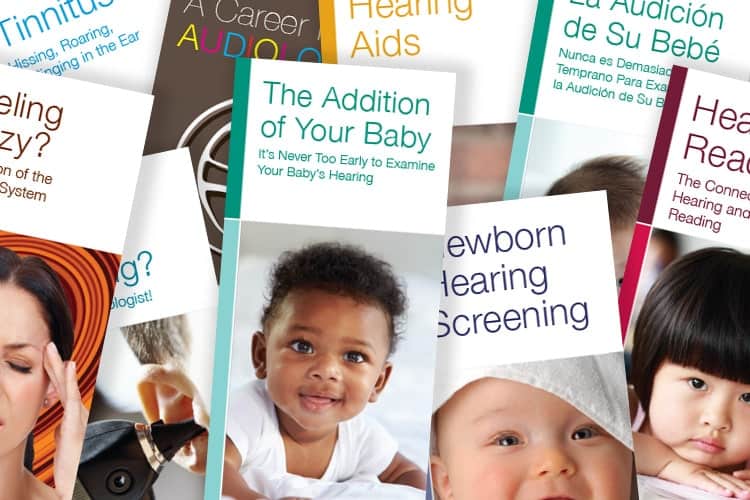In a world where 2.5 billion people are projected to have some degree of hearing loss by 2050 and over 1 billion young adults are at risk of permanent and avoidable hearing loss, it is essential that audiologists effectively communicate hearing and balance care information to consumers.1
To help you reach consumers, the Academy has prepared a wealth of Academy and external resources audiologists can share via their website and social media including:
- Consumer-friendly content: Video, Web Content, Customizable fact sheets
- Member-only brochures
- External organizations doing their part to educate consumers
Share Consumer-Friendly Content
According to a 2013 PEW Research study, eight in ten online health inquiries start at a search engine.2 In 2012, Google reported that users primarily searched for symptoms and conditions. Additionally, searches like these drove nearly three times as many visits.3
Videos
The Academy and its committees have created various educational videos and will continue to do so. We encourage audiologists to share these videos and corresponding website pages via their website or social media to aid in educating consumers about hearing and balance health. (Closed captioning is available for all videos below.)
Why See an Audiologist
According to Nielsen, in 2020, the pandemic boosted online media consumption in the United States by 215%.4 Videos are a quick and easy way of educating and building trust with an audience. According to Statista, 91.4% of users will watch any kind of video; however, at least 28.9% are looking and want to watch educational videos.5
Web Content
Educating patients in and out of the office is essential. Take advantage of the Academy’s consumer-friendly content by sharing a page or link via social media or your practice’s website. (Click the dropdown to see a full list.)
Customizable Fact Sheets
The Academy has prepared these consumer-friendly fact sheets as tools for you to use. Simply download, print, and go. Leave them in the waiting room at your office, the local grocery store, the community center, and the front desk of clinics. Ask the other health-care professionals in your area if they would leave them in their waiting rooms as well.
The bottoms of all the fact sheets are customizable. Simply add your contact information or message in place of the paragraph at the bottom left of the page, next to the logo. (Click on the dropdown to see all available fact sheets.)
Have a suggested resource (website page, video, flyer, etc.) that you would like to have the Academy develop? Email us today!
Member-Only Brochures
The Academy has developed member-only print-ready brochures for your use. These brochures are member-protected. Make sure to log into the Academy website before accessing and downloading the brochures.

External Resources
- Centers for Disease Control and Prevention—Diabetes and Hearing Loss
- Centers for Disease Control and Prevention: Diabetes Education and Care
- Centers for Disease Control and Prevention—Take Charge of Your Diabetes: Healthy Ears
- American Diabetes Association Diabetes and Hearing Loss Website Page
- North Carolina Guide to Diabetes Prevention and Management 2020 Key Messages
- CDC National Center for Environmental Health—DOD Hearing Center of Excellence: Loud Noise Can Cause Hearing Loss
- Working on your lawn this summer? Take care to protect your hearing!
- National Institute on Deafness and Other Communication Disorders (NIDCD)—It’s a Noisy Planet. Protect Their Hearing®
- Gallaudet University: Resource Notebook for Families of Children Who are Deaf or Hard of Hearing
Participate in the Hear Well Campaign
The Hear Well campaign has been launched by the Hearing Industries Association (HIA) with resources on the importance of hearing well, and how seeking out a hearing care professional/audiologist can help you to stay well. You can read and share the Hear Well campaign launch press release, and become an advocate yourself with their outreach resources. Additionally, HIA is promoting various ways a consumer may find a hearing care professional/audiologist, including sharing the Academy’s Find An Audiologist directory via its website.
Ensure consumers can find you by updating your Find an Audiologist profile.
Endnotes
1World Health Organization. (n.d.) Deafness and Hearing Loss. Accessed June 6, 2022.
2Google. (n.d.) The Digital Journey to Wellness: Hospital Selection. Accessed June 7, 2022.
3Fox S, Duggan M. (2020) Health Online 2013. Pew Research Center: Internet, Science, and Tech. Accessed June 7, 2022.
4Nielsen.com. (2020) COVID-19: Tracking the Impact on Media Consumption. Accessed July 1, 2022.
5Ceci L. (2022) Top Video Content Type by Global Reach 2021. Statista. Accessed July 1, 2022.

